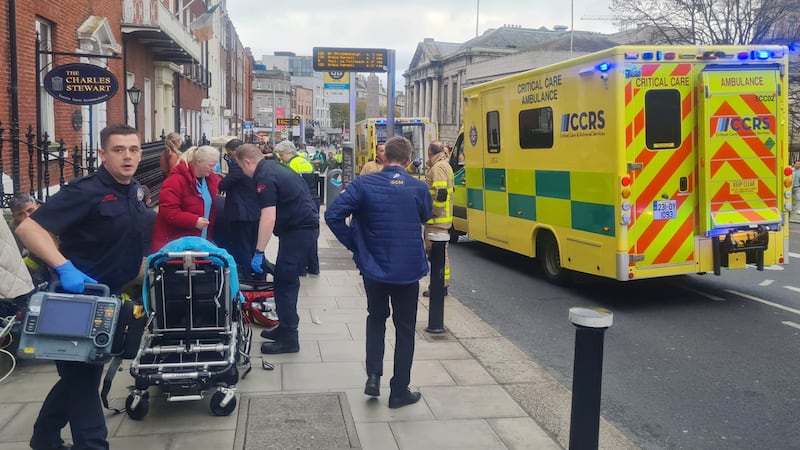A national ceremony to remember all those who died in the Civil War will be held in September, Taoiseach Micheál Martin has announced.
No definitive figure has been provided for those who died in the war which lasted from June 1922 to May 1923.
The best estimates are approximately 1,300, according to the historian James Durney, made up of 730 National Army, 350 IRA and 200 civilians. The IRA dead included 81 men executed by the Government between September 1922 and May 1923.
The plan for a single State ceremony to remember the Civil War was recommended by the Expert Advisory Group on Commemorations.
It will be included in the full Decade of Centenaries programme which the Minister for Culture Catherine Martin will bring before the Cabinet presently.
A national conference on the Civil War will be held in University College Cork between June 15th-18th.
‘Once unthinkable success’
Speaking at a conference to mark the centenary of the handing over of Dublin Castle, the Taoiseach said the transfer of power from the British to the new Irish administration was a “once unthinkable success for Irish nationalism and republicanism”.
However, by the time the Irish Free State came formally into being in December 1922 it “faced divisions and challenges many times more serious than it faced in January” as the country was enmeshed in a bloody civil war.
Mr Martin said the seeds of the tragedy which occurred in Ireland with the Civil War was caused in part by the elongated nature of the British handover which meant that British troops were still in Ireland throughout much of 1922.
"The great failure of 1922 is the number of times when opportunities to at least look for common ground were spurned. Only limited and temporary efforts were undertaken to de-escalate. A momentum built which was subsequently portrayed as inevitable, but there is no reason to believe that other outcomes were not possible," he said.
“Through most of the year, and especially at critical times, London and its representatives in Dublin acted in an inflexible way which both limited the provisional government’s options and reinforced divisions.
“The approach to the Treaty text was, as it had been during the negotiations, about insisting that nothing more could possibly be done.
“It is hard not to wonder if some way back from conflict could have been found if there had actually been a cleaner break on January 16th.”
Mr Martin pointed out that the Anglo-Irish Treaty did not create partition, but its implementation did reinforce the division on the island.
Partition was not an issue in the Treaty debates because most deputies expected that the Northern Irish state was simply unsustainable – or would be as soon as the Boundary Commission had done its work. "Nobody claimed that it would be or should be permanent," he maintained.
Mr Martin said after the Treaty “in almost every way possible bad faith was shown toward the nationalist majority on this island when it came to addressing partition in 1922 and the years following”.
The Council of Ireland set up by the Government of Ireland Act 1920, which was supposed to facilitate co-operation between North and South, was never implemented.
The Boundary Commission, which was supposed to return nationalist-majority areas to the Irish Free State “refused to even consider significant action. While county boundaries had been used to create the border, other approaches were used to block obvious changes to it.
“London’s indifference [to] the reality of the sectarianism faced by Northern nationalists also caused immense damage.
“Partition became a regular part of the pattern of later acceptances of independence, and the parallels with Ireland are unmistakable.
“For the majority, it was a deep and lasting shock to see a divide introduced where they had, until very recently, never considered one to be possible. Their churches, unions, sporting organisations, legislators and much more had never before been divided in this way.
“Even for many unionists this was an unnatural divide which I believe is rightly seen as shaping much of our subsequent history – and not for the good.”
‘Inclusive and collaborative’
Speaking at the conference organised by Trinity College Dublin, Ms Martin said she is committed to ensuring that the final phase of the Decade of Centenaries programme "will be inclusive and collaborative to the greatest extent possible".
The handover of Dublin Castle on January 16th, 1922, will be marked on Sunday with the first State commemoration since the pandemic started.
President Michael D Higgins, Mr Martin and other members of the Government will be in attendance.
Attendance will also include representatives of the Dáil and Seanad Éireann, the diplomatic corps, judiciary, local government, Northern Ireland representatives and descendants of key figures of the time.
Aontú leader Peadar Tóibin said he will not attend the event as the Treaty was a “ disaster for hundreds of thousands of Irish people who still live with its consequences today. As the day is marked, lets not erase the catastrophe that resulted for Northern nationalists.”










